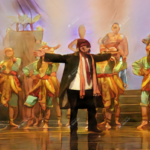-
Table of Contents
- Introduction
- The Significance of Traditional Dances in Indonesian Culture
- 1. The Diversity of Traditional Dances
- 2. The Role of Traditional Dances in Education
- The Challenges Faced by Traditional Dances
- 1. Changing Societal Values
- 2. Lack of Awareness and Appreciation
- 3. Limited Resources and Support
- Efforts to Preserve Traditional Dances
- 1. Cultural Education in Schools
- 2. Cultural Festivals and Competitions
- 3. Collaboration with Tourism Industry
- The Importance of Preserving Traditional Dances
- Conclusion
Introduction

Indonesia is a country rich in cultural diversity, with each region having its own unique traditions and customs. One of the most prominent aspects of Indonesian culture is traditional dance, which plays a significant role in preserving and showcasing the country’s heritage. However, in the modern era, traditional dances face numerous challenges in terms of preservation and popularity. This article will explore the efforts made to preserve traditional dances in Indonesia and the importance of safeguarding these cultural treasures for future generations.
The Significance of Traditional Dances in Indonesian Culture
Traditional dances in Indonesia are not merely forms of entertainment; they are deeply rooted in the country’s history, spirituality, and social fabric. These dances serve as a medium for storytelling, expressing emotions, and conveying religious and cultural beliefs. They are often performed during important ceremonies, such as weddings, harvest festivals, and religious rituals. Traditional dances also play a crucial role in strengthening community bonds and fostering a sense of identity among Indonesians.
1. The Diversity of Traditional Dances
Indonesia is home to more than 17,000 islands, each with its own distinct culture and traditions. Consequently, the country boasts a wide array of traditional dances, each unique to its respective region. For example, the Javanese have the elegant and graceful court dances, such as the Bedhaya and Srimpi, while the Balinese are known for their vibrant and energetic Legong and Barong dances. Other notable traditional dances include the Tor-Tor dance from North Sumatra, the Cakalele dance from Maluku, and the Reog Ponorogo dance from East Java. The diversity of traditional dances reflects the rich cultural tapestry of Indonesia.
2. The Role of Traditional Dances in Education
Traditional dances are not only a means of cultural expression but also serve as educational tools. They provide a platform for passing down historical narratives, legends, and moral values from one generation to the next. Through dance, young Indonesians learn about their ancestors, their heritage, and the values that define their communities. Traditional dances also teach discipline, teamwork, and respect for cultural traditions, instilling a sense of pride and identity in the younger generation.
The Challenges Faced by Traditional Dances
While traditional dances hold immense cultural significance, they face several challenges in the modern era. These challenges threaten their survival and popularity among younger generations. It is crucial to address these issues to ensure the continued preservation of traditional dances in Indonesia.
1. Changing Societal Values
In recent years, Indonesia has experienced rapid modernization and globalization, leading to a shift in societal values. Traditional dances, often seen as relics of the past, struggle to compete with contemporary forms of entertainment. Younger generations are increasingly drawn to Western influences, such as pop music and dance styles, which are perceived as more trendy and modern. As a result, traditional dances are at risk of being marginalized and forgotten.
2. Lack of Awareness and Appreciation
Another challenge faced by traditional dances is the lack of awareness and appreciation among Indonesians, particularly the younger generation. Many young people are unaware of the cultural significance and beauty of traditional dances. This lack of exposure and understanding leads to a decline in interest and participation. Without proper appreciation, traditional dances may lose their place in Indonesian society.
3. Limited Resources and Support
Preserving and promoting traditional dances require resources, including funding, training facilities, and skilled instructors. Unfortunately, many traditional dance groups struggle to secure adequate resources and support. Government funding for cultural preservation is often limited, and private sponsorship is scarce. As a result, traditional dance groups face challenges in maintaining their activities, training new dancers, and organizing performances.
Efforts to Preserve Traditional Dances
Despite the challenges, numerous efforts have been made to preserve and revitalize traditional dances in Indonesia. These initiatives aim to raise awareness, promote appreciation, and provide support for traditional dance groups across the country.
1. Cultural Education in Schools
Recognizing the importance of traditional dances, the Indonesian government has incorporated cultural education into the national curriculum. Students are exposed to traditional dances through music and arts classes, allowing them to learn about and appreciate their cultural heritage from a young age. By integrating traditional dances into formal education, the government hopes to instill a sense of pride and preserve these art forms for future generations.
2. Cultural Festivals and Competitions
Cultural festivals and competitions play a vital role in promoting traditional dances. These events provide a platform for traditional dance groups to showcase their talents and raise awareness among the public. Festivals such as the Bali Arts Festival and the Solo International Performing Arts (SIPA) Festival attract both local and international audiences, fostering appreciation for traditional dances and encouraging their preservation.
3. Collaboration with Tourism Industry
Recognizing the potential of traditional dances as a tourist attraction, the Indonesian government has collaborated with the tourism industry to promote cultural tourism. Traditional dance performances are often included in tour packages, allowing visitors to experience the richness of Indonesian culture firsthand. This collaboration not only generates income for traditional dance groups but also raises awareness and appreciation among both domestic and international tourists.
The Importance of Preserving Traditional Dances
Preserving traditional dances is crucial for several reasons. Firstly, they serve as a link to Indonesia’s rich cultural heritage, connecting present generations with their ancestors. Traditional dances embody the values, beliefs, and stories of the past, providing a sense of continuity and identity. Secondly, traditional dances contribute to the country’s tourism industry, attracting visitors from around the world who are eager to experience Indonesia’s vibrant culture. Lastly, preserving traditional dances is a testament to the diversity and uniqueness of Indonesian culture, fostering national pride and unity.
Conclusion
Traditional dances in Indonesia are not just artistic expressions; they are living embodiments of the country’s cultural heritage. Efforts to preserve and promote these dances are essential to ensure their survival in the face of modernization and changing societal values. By raising awareness, providing support, and integrating cultural education, Indonesia can safeguard its traditional dances for future generations. Preserving these cultural treasures is not only a responsibility but also an opportunity to celebrate the richness and diversity of Indonesian culture.




